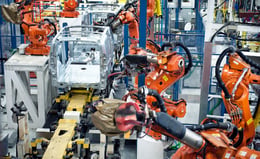4 Important Supply Chain Logistics Conversations for Automakers
Nick Ostdick - January 03, 2017

Those in the automotive supply chain industry are turning their eyes away from the past year and more toward what the next 12 months could hold for OEMs, suppliers, and others in the supply stream. 2017 proved to be the year of technology. Big Data, Industry 4.0, The Internet of Things, and other advancements in data collection were the engines of change and development throughout the automotive industry. The development of these technologies was pushed further by the emergence of new markets and production hubs across the globe, further expanding and diversifying an already variant-rich industry.
We recently discussed some of the biggest takeaways in supply chain management from the past year, but now the question becomes: What’s in store for 2018? What are the questions, conversations, and concerns supply chain planners and managers will be addressing this coming year? What are the topics of greatest importance to an industry that continues to grow, expand, and change at a breakneck pace?
While there isn’t a magical crystal ball for planners and managers to divine predictions, we can certainly make a few educated guesses as to what planners and managers will be concerned with in 2018, and how these issues might shape the automotive supply chain for the next year and beyond.
With that in mind, here are 4 important supply chain logistics conversations planners and managers will have this year and their significance in the greater overall supply stream.
1. Continued demand for increased visibility
As we mentioned a moment ago, the use of intelligent, integrated technology platforms was a key driver in helping redefine the automotive supply chain in 2017. These technologies helped provide planners and managers with greater E2E (end-to-end) visibility into their supply situation, which is a perpetually important conversation for OEMs in fostering increased productivity and efficiency. Expect this conversation to continue in 2018 as OEMs continue to push lean manufacturing principles, especially as demand increases with new and emerging markets and the availability of resources becomes more and more competitive. Industry insiders should also expect the desire for enhanced visibility to move beyond the production floor to warehouse management, yard, dock, and container management, and transportation management as well.
2. Making the supply chain more responsive
Disruptions and bottlenecks happen. Of course planners and managers wish they didn’t, but the fact is no demand planning strategy is 100 percent foolproof, especially in such a variant-rich industry and especially in today’s supply network when fluctuations and alterations to production programs can happen in the blink of an eye. The key is to mitigate the impact of these disruptions and deploy the best safety nets possible to allow OEMs to respond and react quickly and effectively. While once again technology advances in intelligent planning solutions will help drive this movement, expect conversations about fully-integrated operations across each touch point of a company’s value chain to become quite common as companies look to completely digitize and integrate every stage of the production and supply process.
3. The power of customer demand
For OEMs, the importance of customer satisfaction cannot be overstated, especially when it comes to on-time delivery and the state of products when delivered. But what’s likely to come up more and more in 2018 is how customer expectations will drive the technologies suppliers, OEMs, and others within the supply stream will adopt in order to satisfy customers and provide them peace of mind. For example, the proliferation of transportation management solutions to help pinpoint the location, status, and ETA of shipments can in some sense be connected to the desire of customers to know where their orders are at all times. This highlights the power customers have had in recent years in pushing companies to evolve and incorporate new technologies and strategies, and as a result this is an important conversation to keep tabs on in 2018.
4. Growth, growth, growth
As more and more countries and markets develop and become major players in the automotive supply chain - Mexico, China, and potentially Cuba are just a few examples - the subject of growth, expansion, and the logistics behind this is likely to be a key topic in 2018. How do OEM engineer growth and expansion opportunities while still maintaining a hold on their production and supply situation? What kind of technologies must manufacturers leverage to compete in an expanding marketplace? What are the potential pitfalls of rapid, robust growth? What are the liabilities for OEMs as they expand and move into new regions, each of which comes with their own challenges and opportunities? These are the key questions planners and managers will have to address when considering growth and expansion in 2018 and beyond.
Just as 2017 proved to be an exciting year for the automotive supply chain, 2018 is poised to be just as interesting and complex as planners and managers look for new and innovative ways to remain competitive, profitable, and productive in a global market. Without doubt, the handful of potential subjects we’ve just discussed will only be the tip of the iceberg when it comes to examining the state of the global supply chain and how companies position themselves within that system.
If you want to learn more get your Guide to Logistics 4.0
In this Guide you will learn:
-
Why a strategic process in transportation planning is a top priority for digitalization
-
What megatrends will increase supply chain volatility
-
How to manage it
LATEST POSTS
- Understand Circular Economy in The Manufacturing Industry
- How Can Industry 4.0 IT Integration Be Achieved Smoothly?
- The Significance of Order Sequencing in Discrete Manufacturing
- How to improve your Supply Chain Management: The Power of Control Towers
- Optimizing Human Resource Scheduling in Manufacturing: A Technological Approach



